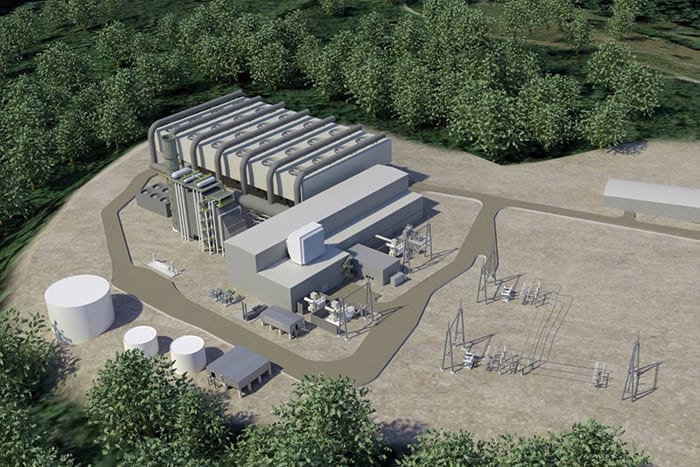ISO-NE Move Puts New Gas-Fired Plant in Doubt
The future of a natural gas-fired power plant planned in northeastern Connecticut is in jeopardy after regional grid operator ISO-New England (ISO-NE) asked the Federal Energy Regulatory Commission (FERC) for permission to end a capacity contract with the project.
Florida-based NTE Energy’s plan to build the 650-MW Killingly Energy Center has been delayed due to permitting issues. NTE Energy secured an obligation in ISO-NE’s 2019 energy supply auction for the 2022-23 supply period, meaning it agreed to produce a certain amount of power at a specific cost that would be funneled into the larger New England power grid.
ISO-NE in a Nov. 4 letter to FERC asked the agency for authorization to cut Killingly from future power considerations, known as Capacity Supply Obligation (CSO) plans. The ISO said its monitoring of the project’s progress found NTE Energy would not hit its “critical path schedule milestones” until more than two years after the start of the agreed-on commitment period. ISO-NE in its filing said, “Killingly was required to achieve commercial operation on June 1, 2022.”
Construction Yet to Begin
The Killingly Energy Center most recently was expected to begin operating in 2024, according to NTE Energy’s project website, which said construction would begin this year, although no ground has been broken. ISO-New England said that projects that secure funding through the auction process must meet development milestones, including financing, permitting, orders for major equipment, and operational startup, but Killingly remains in limbo, prompting the grid operator to ask FERC to end the contract for the plant.
The grid operator’s letter to FERC in part says that after discussions with NTE Energy, ISO-NE is “exercising its right to seek to terminate Killingly’s CSO.” FERC’s acceptance of ISO-NE’s request would enable the grid operator to “draw down the financial assurance” NTE Energy was required to provide to back up the utility’s commitment to the project.
FERC’s approval would enable ISO-NE to remove Killingly’s qualified generation capacity from future plans. The grid operator asked FERC to issue an order within 60 days from the date of the letter and set a date of Jan. 3, 2022 for termination of the contract. ISO-NE is scheduled in February to pick future power generation projects for the grid operator’s support.

Generation Obligations
Developers of projects chosen in the forward capacity auction, if they have problems meeting those development deadlines, are given two years to find other energy providers who can cover their obligations to produce capacity for the power grid. If they are still not able to meet the deadlines, the grid operator can ask FERC for permission to end the contract.
Tim Eves, NTE Energy’s managing partner for development, in an emailed statement said the company is disappointed ISO-NE has decided to end the contract. Eves said the grid operator made an “incorrect assumption” about a deadline date for financing.
“Financing for the Killingly Energy Center is imminent, and this filing will only further delay this much-needed source of cleaner, more affordable energy,” Eves said. “Killingly is a much-needed bridge to the clean energy future, and we will exercise all options available to show FERC that Killingly has not only commenced its construction schedule, but also will be online in time to meet its capacity supply obligations.”
Eves wrote: “While we appreciate all of the work that ISO-NE does, we are disappointed that it has not chosen to come down on our side of this equation. ISO-NE’s determination is based on an incorrect assumption regarding a financing milestone date. Financing for the Killingly Energy Center is imminent, and this filing will only further delay this much-needed source of cleaner, more affordable energy.”
The Killingly Energy Center was among the projects noted by POWER earlier this year in an update on gas-fired power generation in the U.S.
Vocal Opposition
The Killingly plant has been opposed by environmental advocates, who said construction of new natural gas-fired plant is not consistent with state goals to reduce carbon emissions from the power sector.
Connecticut Gov. Ned Lamont also has voiced opposition to the Killingly plant, though his office has said the siting of fossil fuel-powered plants in the region is up to ISO-NE, and not the state. Katie Dykes, commissioner of Connecticut’s Dept. of Energy and Environmental Protection, has criticized the grid operator for its forward capacity auction and for what she said is favoritism toward gas-fired projects. Dykes said such projects are disproportionately sited in Connecticut because it is closer to sources of natural gas than other parts of ISO-NE’s territory.
Kate Donnelly, a member of No More Dirty Power in Killingly, a group opposed to the plant, in a statement said, “People have been fighting construction of the power plant since it was first approved. Even though we were repeatedly told it was a ‘done deal,’ we fought on. With this news, we are hopeful that it is the beginning of the end of the Killingly Energy Center, and we can all focus on meeting our climate goals through energy efficiency programs and the development of renewable resources.”
The Connecticut Siting Council, the agency responsible for approving projects such as the Killingly plant, in February 2019 approved NTE Energy’s petition to refile for a certificate of environmental compatibility and public need, a crucial document needed before construction could move forward. The state Supreme Court in September upheld the Siting Council’s permitting decision amid legal challenges.
Support for the Killingly plant has come from local union workers who want the hundreds of construction jobs that would come with the project. The town council in 2018 approved deals that would bring the area about $5 million in Community Environmental Benefit, or CEBA, money, once the plant was operational. Economists said the plant would provide about $120 million in projected tax revenue over a 20-year lifecycle.
—Darrell Proctor is a senior associate editor for POWER (@POWERmagazine).